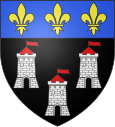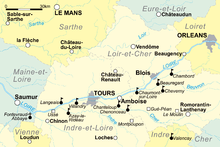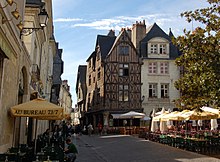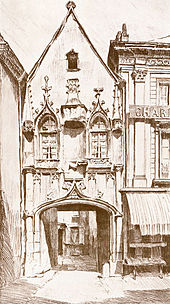Tours
| Tours | ||
|---|---|---|

|
|
|
| region | Center-Val de Loire | |
| Department | Indre-et-Loire ( Prefecture ) | |
| Arrondissement | Tours | |
| Canton |
Tours-1 (main town) Tours-2 (main town) Tours-3 (main town) Tours-4 (main town) |
|
| Community association | Tours Métropole Val de Loire | |
| Coordinates | 47 ° 24 ' N , 0 ° 41' E | |
| height | 44-109 m | |
| surface | 34.36 km 2 | |
| Residents | 135,787 (January 1, 2017) | |
| Population density | 3,952 inhabitants / km 2 | |
| Post Code | 37000, 37100, 37200 | |
| INSEE code | 37261 | |
| Website | www.tours.fr | |
 The Wilson Bridge over the Loire |
||
Tours [ tuːʀ ] is the capital (préfecture) of the French department of Indre-et-Loire in the region of Center-Val de Loire . Tours has 135,787 inhabitants (as of January 1, 2017) and is located on the Loire , between Orléans and the Atlantic coast .
The name of the city is derived from the Turons - an ancient Gallic tribe.
geography
The city is located on the Loire, a little east of the confluence of the Cher in the Loire, whereby the two rivers, which run parallel here at a distance of three kilometers, flow through the city in the north (Loire) and south (Cher).
history
Antiquity
In pre-Roman times, the Celtic Turons settled here , to whom the city owes its current name. The settlement was then on a hill on the right bank of the Loire. The Romans called them Caesarodunum (Caesar's Hill) and transplanted their location to the plain on the left side of the river. It was an important road junction. In 1855 the remains of one of the largest amphitheaters in the Roman Empire were found. It was located directly behind today's cathedral , was built in the 1st century, had an elliptical shape and, after being enlarged in the 2nd century, had axis lengths of around 156 m and 134 m. Tours was destroyed in an attack in 275. At the end of the 3rd century it was given a fortified city wall.
In the second half of the 3rd century, St. Gatianus is mentioned as the first bishop of Tours . He promoted the spread of Christianity here . The first church was built by his successor, Litorius , about a hundred years later . The Saint Martin , consecrated in 372 for the third bishop of Tours, let Gatianus of Tours' bones converted to this church.
In 374 Tours became the capital of Gallia Lugdunensis III. Around the beginning of the 5th century, the name of the city was changed from Caesarodunum to Civitas Turonorum . The inhabitants joined the aremoric league in 435 . In 473 the city was conquered by the Visigoths under Eurich . The Touraine people, however, were against the Arian faith of their new masters. Clovis , king of the Franks , from the Merovingian dynasty , came to Tours in 508, one year after his victory in the Battle of Vouillé over Alaric II , where he dedicated many of the treasures looted by Alaric to the Basilica of St. Martin. Here he received an embassy from the Eastern Roman emperor Anastasios I , who brought him his appointment as consul (probably honorary consul) and Patricius, including the associated insignia and robes.
middle Ages
Since Clovis moved into Tours, this city belonged to the Frankish Empire . The tomb of St. Martin has now become a popular pilgrimage destination, which gave the city of Tours a special symbolic meaning as the home of this national saint.
When the empire was partitioned after Clovis's death (511) Tours fell to his son Chlodomer . When he fell in the Burgundian War in 524 , Tours came into the possession of his brother Chlothar I. From 558, Chlothar ruled the entire Frankish Empire again, but died in 561. Now Tours belonged to the kingdom of Chlothar's son Charibert I. After Charibert's death in 567, the city fell to his brother Sigibert I and thus to Austrasia , but Sigibert's possession of Tours was contested by his half-brother Chilperich I. As a result, Tours was conquered and plundered several times by one and then again by the other party to the dispute, which even the local Bishop Gregory of Tours , author of a history of the Franks , could not prevent. Tours came back to Austrasia through the Treaty of Andelot (587).
In 732, Charles Martell defeated the Moors in the battle of Tours and Poitiers , and the leader of the Moors, Abd ar-Rahman , fell. This victory by Karl Martell prevented further expansion of the Islamic sphere of influence. Under Charlemagne , Tours was the center of the Carolingian Renaissance with an important book illumination and the school of Alcuins , an abbot of Saint-Martin de Tours , who gave his first theology and philosophy lectures here at the end of the 8th century.
Tours became the capital of a Frankish county that was owned by the Etichones in the early 9th century and then came under the rule of the Robertines . In 853 and 903 Tours fell victim to plundering Vikings ( Loire-Normans ). The suburb of Tours, in which the basilica and abbey of Saint-Martin de Tours stood and which had developed into an important municipality under the name Martinopolis , was then surrounded by a strong city wall, built from 906 to 910, and was given the name Châteauneuf . The inhabitants of this suburb often revolted against the chapter of Saint-Martin in order to obtain more communal rights; and only later were these privileges confirmed to them by the French kings.
Theobald the Old took possession of the County of Tours for the House of Blois around 909 . Its representatives subsequently fought a long power struggle against members of the Anjou for supremacy in western France. Theobald III. After his defeat in the Battle of Nouy in 1044 , the Touraine of Blois had to finally cede to Gottfried II of Anjou .
At the end of the 11th century, the Touraine fell to the Plantagenets , and when they became kings of England in 1154, the Touraine also became part of their Angevin Empire . During the reign of John , King Philip II of France was able to regain the territory for France in 1205. But only Heinrich III. of England his claims to Tours and the Touraine finally passed to King Louis IX in 1259 . from France. From 1360 the Touraine was awarded as a duchy to subsequent French princes.
In 1354 Tours was united with the nearby Châteauneuf and surrounded by a common city wall. King Charles VII often and gladly resided in the area, and Louis XI. bought the castle Plessis-lès-Tours in 1463 , which is located in La Riche immediately west of Tours . Ludwig XI lived in this castle. often and here he died in 1483. Tours rose to become a royal secondary residence and had up to 75,000 inhabitants in the 15th century . The French General Estates often met here, for example under Louis XI. 1470, Charles VIII. 1484 and Louis XII. 1506.
Modern times
In the 15th and 16th centuries, the painter Jean Fouquet and several sculptors, notably Michel Colombe and the Juste brothers, who all worked in Tours, contributed to the increase of the city's fame in the field of fine arts. Up until the 16th century, France's king and his court also stayed here regularly. The building of the mighty Gothic cathedral testifies to the importance of the city at this time. Magnificent palaces were built in the city during the Renaissance . Tours experienced an economic boom, not least due to the promotion of silk goods production since King Ludwig XI.
During the Huguenot Wars in 1562, Tours suffered violence from Protestants and Catholics. On April 2nd of that year, Condé seized the city, which led to the looting of church treasures and iconoclastic actions. Marshal Saint-André recaptured Tours for the Catholics on July 10, 1562 , and in the following September and October captured Huguenots were brutally murdered. When after the instigation of King Henry III. If the brothers Henri and Louis de Guise were murdered (December 23/24, 1588), an open battle broke out, Heinrich III. to Tours, moved the Parlement de Paris and the Chamber of Accounts and made a pact with the Huguenot leader Henry of Navarre on April 30, 1589 in the Castle of Plessis-lès-Tours . Shortly afterwards, Mayenne Tours attacked and took the suburb of Saint-Symphorien, but had to withdraw on May 8, 1589 when the King of Navarre approached. After the murder of Heinrich III. (August 2, 1589), the King of Navarre became the new French King as Henry IV, made his solemn entry into Tours on November 21 of that year and relocated the Parliament and the Chamber of Accounts to Paris on March 24, 1594.
The Edict of Nantes , issued in 1598, definitely restored religious peace. In 1621 a riot arose in Tours on the occasion of the funeral of the Protestant Martin Lenoir, and King Louis XIII. had to personally restore order. The city's industry, which was dominated by silk weaving, was badly affected by the repeal of the Edict of Nantes (1685), decreed under Louis XIV .
In 1772 the municipal mint that minted Livres from Tours (librae Turonenses) was closed. During the French Revolution , the city served as a base for republican operations against the Vendée insurgents . In 1845 Tours received a railway connection, which accelerated the city's industrial development. During the Franco-Prussian War , Tours was the seat of the delegation of the Government of National Defense from September 11th to December 10th, 1870. On January 19, 1871, the city was occupied by the Prussian Lieutenant General Julius von Hartmann , and the German troops stayed until March 8, 1871.
In 1920, at the Tours Congress, the French Communist Party was founded. During the Second World War , the city was occupied by the Germans in 1940. A large three-day fire, which was triggered by German artillery fire , fell victim to large parts of the city center. In 1944 the city was hit hard again in Allied bombardments aimed at the strategically important Loire crossing. However, under Mayor Jean Royer, who was in office for 36 years, the historic city center was carefully rebuilt. At the same time, an extensive industrial area was built in the south, on the banks of the Cher, while the François Rabelais University was founded in 1970 , whose campus was not, as is usual, on the outskirts, but centrally on the banks of the Loire. In 1964 several neighboring towns were incorporated.
Religious history: Councils in Tours
Tours was the scene of several councils . The first three were held in 461, 567 and 813 and mostly dealt with church discipline. At another council, held in 1050, the theologian Berengar von Tours was refuted by Lanfrank von Bec , denounced as a heretic, and by Pope Leo IX. sentenced. At the council of 1096, Bishop Otto of Strasbourg submitted to Pope Urban II and was accepted into Gregorian obedience on the condition that he participated in the First Crusade . In May 1163, Pope Alexander III held held a council in Tours at which he, with the excommunication of the antipope Viktor IV , was recognized as the rightful Pope and the measures against the Cathars were renewed. The councils of 1236 and 1282 again dealt specifically with matters of church discipline. In September 1510, King Ludwig XII. a council in Tours to obtain the approval of the French prelates to war against Pope Julius II . Another council was held here in 1583.
Attractions
Significant sights of the city are:
- Saint Gatien Cathedral
- New Saint-Martin Basilica with St Martin's burial place
- Saint-Julien Abbey Church
- Archbishop's Palace, now the seat of the Museum of Fine Arts of Tours
- Former College of Saint Martin
- Hotel Goüin
- La Psalette Monastery
- Marmoutier Monastery
- Building of the former Saint-Eloi Brotherhood
- Botanical Garden
- Le Musée du Compagnonnage
- Synagogue , built in 1908
politics
Mayor of the city of Tours and successor to Jean Royer between 1995 and 2014 was Jean Germain from PS . He was previously Rector of Tours University , Vice President of the Center Region and Senator for the Indre-et-Loire Department . Serge Babary was elected mayor in 2014 and entered the French Senate in 2017 . Christophe Boucher from the UDI has been the new mayor since then .
Town twinning
-
 Mülheim an der Ruhr , North Rhine-Westphalia (since 1962)
Mülheim an der Ruhr , North Rhine-Westphalia (since 1962) -
 Segovia , Spain (since 1972)
Segovia , Spain (since 1972) -
 Parma , Italy (since 1976)
Parma , Italy (since 1976) -
 Luoyang , China (since 1982)
Luoyang , China (since 1982) -
 Springfield, MO , United States (since 1984)
Springfield, MO , United States (since 1984) -
 Trois-Rivières , Canada (since 1987)
Trois-Rivières , Canada (since 1987) -
 Takamatsu , Japan (since 1988)
Takamatsu , Japan (since 1988) -
 Brașov , Romania (since 1990)
Brașov , Romania (since 1990) -
 Minneapolis , United States (since 1991)
Minneapolis , United States (since 1991)
coat of arms
Blazon : "Under a blue shield head, in it three golden heraldic lilies, in black three round three-pinned, black-jointed towers, at the base further silver towers, 2: 1 set, with an open gate and red, flag-studded tent roofs."
Although the name Tours etymologically has nothing to do with French tours (towers), this is a speaking coat of arms, as it reveals the name Tours through the tower symbols .
economy
The economy of the Agglomeration Tours is diversified, with numerous medium-sized and larger companies in industry and services, the largest single company is the university hospital.
The Touraine , the region around Tours, is known for its wines. The most famous growing area of Touraine is Vouvray , which is located just outside the city of Tours.
traffic
As a Loire crossing, Tours has always been of great importance in terms of transport.
There is a motorway connection via the A10 ( Paris - Bordeaux ), the A85 (Tours - Angers ) and the A28 (Tours - Le Mans ).
Tours main station is a terminus with a connection to the TGV network. Here the line to Saint-Nazaire branches off from the Paris – Bordeaux line . Trains from Paris via Tours in the direction of Bordeaux, however, stop at Saint-Pierre-des-Corps station, about five kilometers from Tours-Mitte , which was converted into a long-distance train station in 1990. There are also direct regional connections to Le Mans and Bourges. The city's airport is located six kilometers northeast of the Loire .
A tram line has been running through the city in a north-south direction since September 2013 . A tram operated as early as 1900 to 1949; it was abandoned in favor of bus transport.
Education and culture
The University of Tours is called Université François-Rabelais .
Tours has an opera house and a symphony orchestra, as well as several smaller stages and a fine arts museum.
The congress center Vinci - Center International de Congrès has space for 2000 visitors.
Personalities
Bishops
sons and daughters of the town
Born before the 20th century
- Beginning of the 11th century: Berengar von Tours , theologian († 1088)
- around 1420: Jean Fouquet , painter († 1478/81)
- 1434: Jolande of France , daughter of King Charles VII of France († 1478)
- around 1445: Jacques de Beaune , financial politician, Baron de Semblançay († 1527)
- around 1445: Guillaume Briçonnet , cardinal and archbishop of Narbonne († 1514)
- 1457: Jean Bourdichon , painter and illuminator of manuscripts († 1521)
- 1510: François Clouet , painter († 1572)
- 1591: Jacques Dupuy , humanist and librarian († 1656)
- 1593: Claude Vignon , Baroque painter († 1670)
- 1599: Marie de l'Incarnation (civil: Guyart), nun, mystic and missionary († 1672)
- around 1604: Abraham Bosse , engraver and etcher († 1676)
- 1621: René Rapin , Jesuit and philologist († 1687)
- 1680: Philippe Néricault Destouches , comedy poet († 1754)
- 1682: Ursin Durand , Benedictine and historian († 1771)
- 1683: Jean-Baptiste de Grécourt , poet († 1743)
- 1686: Jacques Hardion , historian, translator and royal librarian († 1766)
- 1686: Julien Le Roy , watchmaker († 1759)
- 1730: Louis Dutens , writer († 1812)
- 1754: Jean-Baptiste Meusnier de la Place , mathematician and general († 1793)
- 1758: Armand Samuel de Marescot , engineer officer (Génie militaire) († 1832)
- 1765: Joseph-Michel Dutens , civil engineer and economist († 1848)
- 1792: Philippe Musard , violinist, conductor and composer († 1859)
- 1795: Gabriel Lamé , mathematician and physicist († 1870)
- 1799: Honoré de Balzac , writer († 1850)
- 1801: Félix Dujardin , naturalist, geologist and zoologist († 1860)
- 1801: Armand Trousseau , internist († 1867)
- 1805: Adolphe Delattre , ornithologist and artist († 1854)
- 1815: Ernest Goüin , mechanical and civil engineer and entrepreneur († 1885)
- 1815: Jules Moinaux , librettist († 1896)
- 1824: Jules Haime , zoologist, paleontologist and geologist († 1856)
- 1830: Paul Duboy , sculptor († 1886)
- 1843: Émile Delahaye , entrepreneur, automobile pioneer and founder of the Delahaye car brand († 1905)
- 1845: Auguste Brachet , Romanist († 1898)
- 1850: Victor-Alexandre-Frédéric Laloux , architect (Gare d'Orsay) († 1937)
- 1850: Louis Muraton , painter († 1901)
- 1853: René du Coudray de La Blanchère , Classical archaeologist († 1896)
- 1858: Maurice Couette , physicist († 1943)
- 1858: Georges Courteline , novelist and dramaturge († 1929)
- 1874: Elisabeth Sonrel , Art Nouveau painter († 1953)
- 1881: Eugène Flaud , racing car driver († 1950)
- 1883: Émile Vacher , musician († 1969)
- 1887: Albert Ouriou , racing car driver († 1955)
- 1897: Yves Lejarre , railroad worker, resistance fighter against the Nazi regime and prisoner in Dachau concentration camp († 1945)
- 1899: Bernard Hardion , diplomat († 1986)
Born in the 20th century
- 1902: Henri Deglane , wrestler and Olympic champion from 1924 († 1975)
- 1903: Guy Paquinet , jazz trombonist and band leader († 1981)
- 1905: Paul Nizan , writer († 1940)
- 1906: Louis Parrot , poet, essayist, journalist and translator († 1948)
- 1907: Dora Maar (Henriette Theodora Markovitch), photographer and painter († 1997)
- 1917: René Laurentin , theologian and Mariologist († 2017)
- 1923: Yves Bonnefoy , poet, author, translator and university lecturer († 2016)
- 1925: James Coignard , painter and graphic artist († 2008)
- 1927: Paul Guers (Paul Jacques Dutron), actor
- 1940: Philippe Lacoue-Labarthe , philosopher, literary critic and translator († 2007)
- 1943: Jean-Louis Bruguière , chief French investigative judge and Vice-President of the Tribunal de Grande Instance in Paris
- 1943: Hans-Günther Kaufmann , German photographer
- 1949: Jean-Marc Lelong , comic artist († 2004)
- 1950: Philippe Briand , French politician (Les Républicains)
- 1951: Jacques Villeret , actor († 2005)
- 1952: Dominique Bussereau , politician
- 1954: Yves Ker Ambrun , known as YKA, comic artist († 2017)
- 1960: Olivier de Germay , priest and bishop of Ajaccio in Corsica
- 1960: Pascal Guimier , journalist
- 1962: Luc Delahaye , photographer
- 1964: Stéphane Audeguy , writer, literary scholar and teacher
- 1964: Pascal Hervé , racing cyclist
- 1967: Laurent Mauvignier , writer
- 1968: Xavier Gravelaine , national soccer player
- 1969: Frédéric Magné , cyclist
- 1970: Laurent Itti , researcher and professor of computer science, psychology and neuroscience
- 1972: Luz (Rénald Luzier), caricaturist, cartoonist and comic artist
- 1973: Nâdiya (Nadia Zighem), singer
- 1974: Rubin Steiner (Frédérick Landier), musician and DJ
- 1977: Jean-Sébastien Jaurès , football player
- 1979: Isabelle Stoehr , squash player
- 1980: Zaz (Isabelle Geffroy), singer
- 1982: Wilfried Dalmat , soccer player
- 1983: Cyril Lemoine , racing cyclist
- 1983: Jérémy Roy , racing cyclist
- 1984: Ben l'Oncle Soul (Benjamin Duterde), musician
- 1985: Mélanie Bernier , actress
- 1986: Josselin Ouanna , tennis player
- 1988: Yohan Tavares , soccer player
- 1989: Wilfried Cailleau , Nordic combined skier
- 1991: Pierre-Étienne Lemaire , football player
- 2000: Sofiane Diop , football player
Climate table
| Tours | ||||||||||||||||||||||||||||||||||||||||||||||||
|---|---|---|---|---|---|---|---|---|---|---|---|---|---|---|---|---|---|---|---|---|---|---|---|---|---|---|---|---|---|---|---|---|---|---|---|---|---|---|---|---|---|---|---|---|---|---|---|---|
| Climate diagram | ||||||||||||||||||||||||||||||||||||||||||||||||
| ||||||||||||||||||||||||||||||||||||||||||||||||
|
Average monthly temperatures and rainfall for Tours
Source: wetterkontor.de
|
|||||||||||||||||||||||||||||||||||||||||||||||||||||||||||||||||||||||||||||||||||||||||||||||||||||||||||||||||||||||||||||||||||||||||||||||||||||||||||||||||||||
literature
- Le Patrimoine des Communes d'Indre-et-Loire. Flohic Editions, Volume 2, Paris 2001, ISBN 2-84234-115-5 , pp. 1263-1350.
- Ulrich Nonn : Tours and Poitiers. In: Reallexikon der Germanischen Altertumskunde (RGA). 2nd Edition. Volume 31, Walter de Gruyter, Berlin / New York 2006, ISBN 3-11-018386-2 , pp. 106-108.
Web links
- Official website of the city
- Local tourist office
- Tours and the surrounding area Video (WMV)
- Illustration by Daniel Meisner from 1626: Tours. Rustica gens est optima flens et pessima ridens ( digitized version )
Individual evidence
- ↑ France: First tram in Tours goes into operation ( Memento des original from October 5, 2013 in the Internet Archive ) Info: The archive link has been inserted automatically and has not yet been checked. Please check the original and archive link according to the instructions and then remove this notice. . In: ÖPNV aktuell, September 5, 2013, accessed on July 6, 2014: “With 21 seven-part and 43 m long vehicles, almost 55,000 passengers are to be transported every day. In a provincial town, the tram is the event of the century, ”reports the local newspaper“ La Nouvelle République ”.







